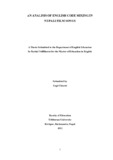Please use this identifier to cite or link to this item:
https://elibrary.tucl.edu.np/handle/123456789/1530| Title: | An Analysis of English Code Mixing In Nepali Film Songs |
| Authors: | Chhetri, Gopi |
| Keywords: | English language;Education english;Code mixing song;Nepali film song |
| Issue Date: | 2012 |
| Publisher: | Faculty of Education Tribhuvan University Kirtipur, Kathmandu, Nepal |
| Abstract: | This research work entitled “An Analysis of English Code Mixing in Nepali Film Songs” was carried out to find out the English code mixing in Nepali film songs and context and reasons for English code mixing in Nepali film songs. In order to collect the data, secondary sources were used. The secondary data were collected from different F.M. radio stations from Kathmandu and Butwal. I transcribed 120 Nepali film songs from which I selected 20 songs for the analysis. The findings of the study showed that out of 5722 codes 341 codes were mixed in Nepali film songs which occupied 5.95% of the total codes. It is also found that from total 341 codes, nouns have occupied the greater percentage i.e. 65.98%. Likewise, verbs have occupied 6.45%, prepositions 2.34%, adjectives 17.30%, and exclamations 7.91%. While analyzing the sentence level code mixing, I found only 7 English sentences out of 33 sentences in the Nepali film songs. The study concluded that the popularity of English language as the major reason of English code mixing in Nepali film songs. The study also found that English codes have occurred in different situations i.e. in order to persuade, to make others happy, to establish relationship, while greeting and to describe or praise others. This thesis has been divided into four chapters. The first chapter consists of the introduction of the study. This chapter consists of general background, review of the related literature and objectives and significance of the study. The second chapter deals with the methodology, sources of data, sampling procedure and limitations of the study. Similarly, the third chapter presents the analysis and interpretation of the data collected by the researcher. Finally, the fourth chapter includes the findings and recommendations on the basis of analysis and interpretation of the collected data. References and the appendices have been presented at the end of the research. |
| URI: | http://elibrary.tucl.edu.np/handle/123456789/1530 |
| Appears in Collections: | English Language Education |
Files in This Item:
| File | Description | Size | Format | |
|---|---|---|---|---|
| Gopi Chhetri Thesis CD 8707.pdf | 261.78 kB | Adobe PDF |  View/Open |
Items in DSpace are protected by copyright, with all rights reserved, unless otherwise indicated.
